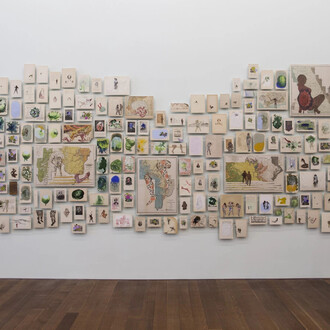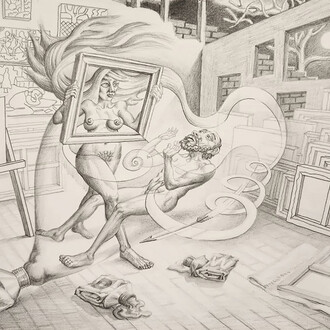Born in Nigeria and now based in Antwerp, Otobong Nkanga explores the contested social and political histories of colonialism, with a particular focus on the relationship between Africa and the Western world. She does this through performance, drawing, photography, and installation—examining how raw minerals are transported through various covert economies and how they are transformed into desirable consumer objects.
Nkanga is fascinated with what she has referred to as “glimmer” and “shine,” the surface qualities of natural resources such as mica, a mineral that is used in makeup and turned into an object of seduction. This interest has led the artist far and wide, studying the intense mining of the world’s natural resources since the rise of late capitalism. One of the primary means by which the artist’s interest manifests is through the body. In Nkanga’s works on paper and her tapestries, the body becomes a border implicated within the field of mining.
Nkanga acts as a cultural anthropologist—tracing the violent means by which contested minerals and objects are exhumed from their natural environments, such as Nigeria and Namibia—and considers how they are transported to the West. Through her work, the artist re-imagines our relationship to our everyday environment.
Otobong Nkanga’s first ever US survey exhibition, To Dig a Hole That Collapses Again, takes its name from the “Green Hill” in Namibia. The name is a direct translation of the town that houses it, Tsumeb, one of Namibia's "rare gems."
The exhibition is organized by Omar Kholeif, former Manilow Senior Curator and Director of Global Initiatives. It is presented in the Bergman Family Gallery on the museum’s second floor.
















